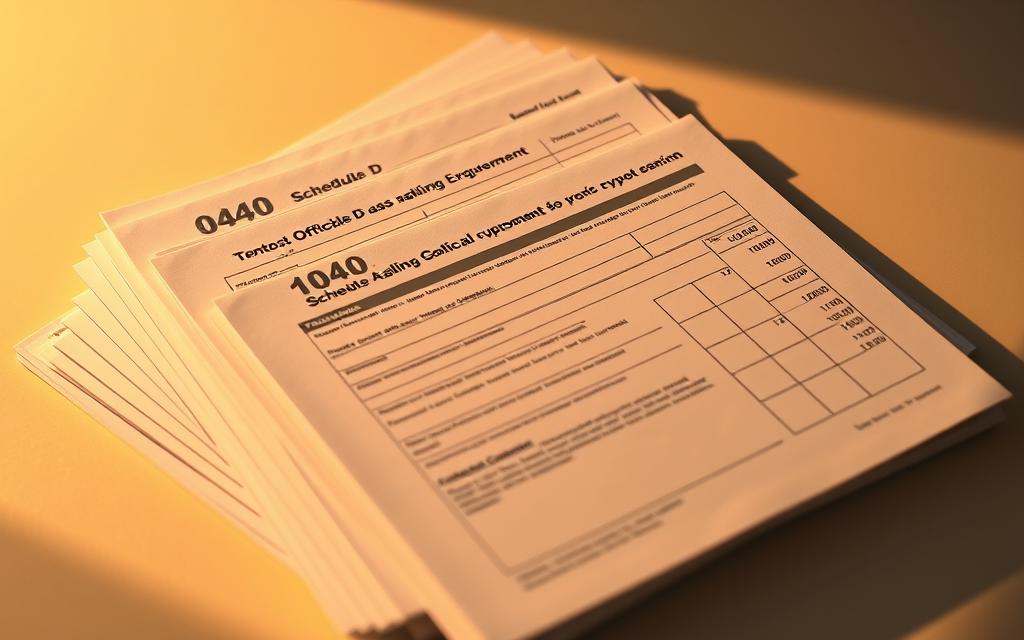Table of Contents
The IRS classifies digital assets like Bitcoin and Ethereum as property, not currency. This means every trade, sale, or exchange triggers potential tax implications. Whether you’re an active trader or a long-term holder, knowing the rules is essential.
Capital gains and losses apply to crypto transactions, similar to stocks. Short-term holdings (under one year) face higher rates than long-term investments. Proper record-keeping ensures accurate reporting and avoids penalties.
Tax software like TurboTax simplifies tracking, supporting up to 20,000 transactions. Since 2020, the IRS has intensified enforcement, making compliance critical. For strategies on minimizing liabilities, explore capital gains tax optimization.
How Cryptocurrency Taxation Works in the US
Since 2014, the IRS has enforced crypto taxation similar to physical assets. Under IRS Notice 2014-21, digital currencies are classified as property, not currency. This means every transaction may trigger a taxable event, just like selling stocks or real estate.
IRS Classification of Crypto as Property
The IRS treats cryptocurrencies as capital assets. Gains or losses from trading or selling are subject to capital gains tax. Key implications include:
- Mining rewards count as income at fair market value.
- Staking yields are taxable upon receipt.
- Airdrops require reporting as ordinary income.
Taxable vs. Non-Taxable Crypto Events
Not all blockchain activity triggers taxes. Below is a breakdown:
| Taxable Events | Non-Taxable Events |
|---|---|
| Selling crypto for fiat | Transferring between personal wallets |
| Trading BTC for ETH | Gifting crypto under $16,000/year |
| Using crypto to buy goods | Donating to qualified charities |
Example: Converting Bitcoin to Ethereum is a taxable event. You’ll owe capital gains tax on the BTC’s value increase since purchase.
Tools like TurboTax Premium simplify tracking, supporting 10,000+ transactions. Always maintain records—blockchain’s transparency aids IRS audits.
How Much Taxes Do I Have to Pay on Cryptocurrency?
Tax rates for digital assets vary based on holding periods and income levels. The IRS applies progressive brackets, with short-term gains taxed higher than long-term holdings. Proper classification ensures accurate reporting and minimizes liabilities.
Short-Term Capital Gains Tax Rates (2024)
Profits from assets held under one year align with ordinary income tax brackets. Rates range from 10% to 37%, depending on taxable income. Below are the 2024 thresholds for single and joint filers:
| Tax Rate | Single Filers | Married Filing Jointly |
|---|---|---|
| 10% | Up to $11,600 | Up to $23,200 |
| 22% | $47,150–$100,525 | $94,300–$201,050 |
| 37% | Over $609,350 | Over $731,200 |
“Short-term gains lack the preferential rates of long-term holdings, making timing a critical factor.”
Long-Term Capital Gains Tax Rates (2024)
Assets held over one year qualify for reduced rates (0%, 15%, or 20%). Income thresholds determine the bracket:
- 0%: Single filers earning ≤$47,025; joint filers ≤$94,050.
- 15%: Single $47,026–$518,900; joint $94,051–$583,750.
- 20%: Incomes exceeding upper limits.
Example: A single filer with $50,000 in taxable income pays 15% on long-term gains. TurboTax’s crypto calculator simplifies these projections.
State taxes add complexity. California taxes crypto at up to 13.3%, while Texas imposes no income tax. Always verify local regulations.
Calculating Your Crypto Tax Liability
Accurate crypto tax reporting starts with understanding your cost basis. This foundational figure determines your gains or losses when disposing of an asset. Even small errors can lead to overpayment or IRS scrutiny.
Determining Cost Basis
Your cost basis includes the original purchase price plus any transaction fees. For example:
- Buying BTC: A $1,000 purchase with a $20 fee creates a $1,020 basis.
- Partial sales: Selling 0.5 ETH requires prorating the basis proportionally.
“The IRS allows FIFO (First-In-First-Out) or LIFO (Last-In-First-Out) methods. FIFO is default, but LIFO may reduce tax liability in volatile markets.”
Adjusting for Fees and Transactions
Exchange fees, gas fees, and mining costs can all adjust your basis. Tools like TurboTax automate this, but manual tracking requires:
- Dated records of every transaction.
- Receipts for fees paid.
- Historical price data from CoinMarketCap or exchanges.
Case Study: An 18-month ETH investment bought at $2,500 (with $30 fees) and sold at $4,000 has a $1,470 gain ($4,000 – $2,530 basis). Long-term rates apply.
Taxable Cryptocurrency Transactions
Understanding which crypto activities trigger tax obligations helps avoid costly mistakes. The IRS defines a taxable event as any action that changes your asset’s ownership or value. Below are the most common scenarios requiring reporting.

Selling Crypto for Fiat Currency
Converting digital assets to USD or other government-issued money always creates a capital gain or loss. For example, selling Bitcoin for $50,000 after buying it at $30,000 yields a $20,000 taxable profit.
Exchanges like Coinbase issue Form 1099-B for sales exceeding $600. Even without forms, you must self-report all transactions.
Trading Between Cryptocurrencies
Swapping one token for another (e.g., Litecoin to Ethereum) counts as a taxable event. The IRS treats this as selling LTC for USD, then buying ETH—even if no fiat was involved.
“Crypto-to-crypto trades require calculating gains based on fair market value at the transaction time.”
Using Crypto for Purchases
Buying goods or services with digital assets triggers taxes. For instance, spending 0.1 BTC ($4,000) on a laptop when your cost basis was $2,500 means reporting a $1,500 capital gain.
Debit cards linked to crypto accounts often create multiple small taxable events. Platforms like TurboTax aggregate these for streamlined filing.
Other Reportable Activities
- Stablecoin conversions: Trading USDC for DAI is taxable, unlike fiat-to-stablecoin purchases.
- NFT purchases: Using ETH to buy art? The ETH’s appreciation since purchase is taxable.
- Like-kind exchanges: Pre-2018 swaps (e.g., BTC for BCH) were tax-deferred. Now, all trades are taxable.
Exchanges report high-volume users to the IRS via Form 1099-K. Whether you receive one or not, meticulous records are non-negotiable.
Reporting Crypto Income
Earning digital assets through mining or services triggers tax obligations under US law. The IRS treats these earnings as ordinary income, taxed at your marginal rate. Proper reporting avoids penalties and ensures compliance.
Mining and Staking Rewards
Mining rewards are taxed as self-employment income if done as a business. Hobby miners report earnings as “other income” on Schedule 1. Key distinctions:
- Business mining: Requires Schedule C and may owe self-employment tax (15.3%).
- Staking rewards: Taxable at fair market value when received, even if unsold.
“Crypto mining income is subject to both income tax and self-employment tax if conducted for profit.”
TurboTax’s self-employment module simplifies tracking deductions like hardware costs and electricity. For rewards exceeding $600, exchanges issue Form 1099-NEC.
Receiving Crypto as Payment
Getting paid in digital assets counts as taxable income. The value in USD at receipt determines your basis. For example:
| Scenario | Tax Treatment |
|---|---|
| $200 Litecoin for freelance work | Report $200 as ordinary income |
| Crypto payroll (no withholding) | Employee pays estimated taxes quarterly |
Case Study: A developer receives 0.05 BTC ($2,000) for a project. They report $2,000 as income and track the BTC’s basis for future sales.
Airdrops and Hard Forks: Tax Implications
Free crypto distributions like airdrops and hard forks come with hidden tax obligations. The IRS treats these events as taxable, requiring recipients to report them as income. Proper documentation ensures compliance with evolving regulations.
When Free Isn’t Free: Ordinary Income Rules
Under IRS Revenue Ruling 2019-24, airdropped tokens count as ordinary income at their fair market value when received. This applies whether:
- Tokens appear in your wallet automatically
- You claim them through decentralized platforms
- The distribution comes from a protocol upgrade
“Hard forks creating new crypto assets are taxable when you gain control over the new asset.”
Valuation Challenges and Timing
Determining fair market value can be complex for new tokens. The IRS requires using exchange prices at receipt time. Key considerations:
- Exchange-listed tokens: Use the opening price on receipt date
- Unlisted tokens: Document comparable sales or developer estimates
- Wallet snapshots: Fork valuation occurs when new chain becomes operational
Case Study: A 2020 UNI airdrop worth $5,000 at claim time would be reported as $5,000 in ordinary income, regardless of later price changes.
TurboTax’s crypto module helps categorize these distributions correctly. Always maintain records of:
- Receipt dates and times
- Supporting price data
- Wallet addresses involved
Unlike capital gains, these amounts appear on Schedule 1 as “other income.” The basis becomes the fair market value reported, affecting future sale calculations.
Crypto Gifts and Donations
Donating digital assets can unlock unique tax benefits while supporting causes you care about. The IRS treats crypto donations differently than cash, offering potential advantages for strategic givers. Proper documentation ensures you maximize deductions and comply with regulations.
Charitable Contribution Deductions
Giving crypto to qualified charities may eliminate capital gains tax. When you donate appreciated digital assets held over one year, you can deduct the fair market value without recognizing gains.
- Form 8283 requirement: Donations exceeding $250 need written acknowledgment from the charity.
- Valuation services: Use IRS-approved methods to determine crypto value at donation time.
- Carryover basis: The charity inherits your original cost basis when selling the asset.
“Donor-advised funds allow anonymous crypto gifts with immediate tax deductions, even if distributions occur later.”
Gift Tax Rules for Crypto
Transferring digital assets to individuals follows different IRS guidelines than charitable giving. Key thresholds apply:
| Scenario | Tax Treatment |
|---|---|
| Gifts under $16,000/year | No reporting required (2024 limit) |
| Lifetime gifts exceeding $12.92M | Federal gift tax applies |
| Inherited crypto | Recipient gets step-up basis to date-of-death value |
Example: Giving 1 BTC ($40,000) to your child counts against your $16,000 annual exclusion and $12.92M lifetime limit. TurboTax’s gift tax calculator helps track these amounts.
For inherited crypto, proper valuation ensures accurate basis calculations. Professional appraisals may be necessary for estates exceeding $12.92M.
Lost or Stolen Cryptocurrency
Dealing with missing digital assets presents unique challenges for tax reporting. Unlike traditional investments, proving loss or theft in the crypto space requires meticulous documentation. The IRS has specific rules governing these situations, though recent legislation limits deduction opportunities.

IRS Rules on Casualty Losses
The Tax Cuts and Jobs Act (TCJA) suspended most casualty loss deductions until 2026. However, exceptions exist for federally declared disasters. For crypto losses, you must prove:
- Direct ownership through wallet keys or exchange records
- Irrecoverable status with police reports or bankruptcy filings
- Fair market value at time of loss
“Exchange hacks like Mt. Gox established precedent for treating stolen crypto as capital losses, not casualty deductions.”
Form 4684 remains necessary for eligible claims. TurboTax’s loss documentation features help organize:
- Private key management audit trails
- Exchange correspondence about breaches
- Insurance claim denials
Limitations on Deductions
The IRS imposes strict conditions for recognizing crypto losses. Key restrictions include:
| Scenario | Tax Treatment |
|---|---|
| Exchange bankruptcy (e.g., Celsius Network) | Capital loss when assets become unrecoverable |
| Hardware wallet failure | No deduction without proof of theft |
| Insurance recoveries | Reduces deductible loss amount |
Security best practices minimize risks. Use hardware wallets and maintain:
- Dated screenshots of balances
- Transaction hash records
- Multi-signature setups for large holdings
For assets lost before 2018, different rules may apply. Consult a tax professional for complex cases involving foreign exchanges or decentralized platforms.
Tax-Free Crypto Transactions
Strategic crypto investors leverage tax-free opportunities to maximize returns. The IRS permits certain transactions without immediate tax consequences, particularly for long-term holdings and retirement accounts. Understanding these exceptions helps optimize your investment strategy while maintaining compliance.
Holding Versus Selling
Simply owning digital assets never triggers taxable events. The buy-and-hold approach delays taxes indefinitely until disposal. Key advantages include:
- 0% long-term rate: Single filers earning ≤$47,025 pay nothing on assets held over one year
- Compounding growth: Untaxed appreciation increases reinvestment potential
- Simplified reporting: No Form 8949 required for unrealized gains
TurboTax’s portfolio tracker helps monitor holding periods automatically. Remember that transferring between personal wallets maintains tax-free status, provided you control both addresses.
Tax-Advantaged Retirement Accounts
IRAs and 401(k)s offer powerful crypto tax shelters. Contribution limits for 2024 include:
| Account Type | Under 50 Limit | 50+ Catch-Up |
|---|---|---|
| Traditional IRA | $7,000 | $8,000 |
| Roth IRA | $7,000 | $8,000 |
| 401(k) | $23,000 | $30,500 |
“Roth IRAs provide tax-free growth – qualified withdrawals of crypto gains face zero federal taxes after age 59½.”
Specialized platforms like Bitcoin IRA facilitate crypto investments within retirement structures. Avoid prohibited transactions like self-dealing, which can trigger full account taxation.
Crypto Tax Forms You Need to Know
Navigating crypto taxes involves specific documentation for compliance. The IRS requires distinct tax forms to report crypto transactions, mining income, and foreign holdings. Using the correct forms minimizes audit risks and ensures accurate filings.

Form 8949 and Schedule D
Form 8949 details capital gains and losses from crypto sales or trades. Key requirements include:
- Acquisition/disposal dates: Track holding periods for rate calculations.
- Cost basis adjustments: Include fees and transaction costs.
- Broker vs. non-broker: Check Box A (broker-reported) or Box C (self-reported).
TurboTax auto-populates Schedule D using Form 8949 data. For NFTs, classify as “digital asset” in Part I with a description (e.g., “Bored Ape NFT”).
“Mismatched Form 8949 totals trigger IRS notices. Always reconcile with Schedule D line totals.”
Form 1099-NEC for Mining Income
Mining rewards exceeding $600/year generate Form 1099-NEC. Report this as taxable income on Schedule 1 (Line 8). Key considerations:
| Form Type | Use Case | Reporting Threshold |
|---|---|---|
| 1099-NEC | Mining/staking as a business | $600+ |
| 1099-MISC | Coinbase rewards (pre-2023) | $600+ |
| 1099-K | Exchange payments (200+ transactions) | $20,000+ |
Amend past filings using Form 1040-X if errors occur. For foreign accounts holding crypto, FBAR (FinCEN 114) applies to balances over $10,000 annually.
How the IRS Tracks Cryptocurrency
The IRS employs advanced methods to monitor digital asset activities. From exchange reporting to blockchain forensics, understanding these tracking mechanisms helps ensure compliance. Authorities combine traditional financial oversight with cutting-edge technology to identify unreported crypto transactions.
Exchange Reporting Requirements
Major platforms must report user activity under IRS rules. Key reporting thresholds include:
- Form 1099-K: Issued for users with $20,000+ in transactions and 200+ transfers
- John Doe summons: Court orders like the 2016 Coinbase case compel data disclosure
- Travel Rule compliance: Exchanges share sender/receiver details for transfers over $3,000
“The IRS Criminal Investigation Division closed over 2,500 crypto cases in 2022, with $7 billion in seized digital assets.”
Blockchain Analytics Techniques
Public ledgers enable sophisticated tracking methods. The IRS contracts firms like Chainalysis to:
| Method | Application | Limitations |
|---|---|---|
| Wallet clustering | Links addresses to real identities | Less effective for privacy coins |
| Transaction pattern analysis | Identifies mixing service usage | Requires exchange cooperation |
| UTXO tracking | Follows specific coin movements | Challenged by CoinJoin transactions |
TurboTax’s audit risk assessment considers these factors when preparing filings. Recent sanctions on tools like Tornado Cash demonstrate increasing enforcement.
Privacy coins present unique challenges for regulators. While Monero and Zcash transactions appear opaque, associated money movements through exchanges often create detectable patterns.
Record-Keeping Best Practices
Robust record-keeping transforms crypto tax filing from chaotic to streamlined. The IRS requires documentation for all transactions, including purchases, sales, and trades. Proper organization minimizes errors and provides audit protection for seven years.

Essential Transaction Details
Every crypto activity needs these core details recorded:
- Date and time of transaction (UTC timestamp preferred)
- Amount in crypto and USD fair market value at execution
- Counterparty wallet addresses or exchange details
- Network fees and gas costs affecting cost basis
“Disorganized records account for 73% of crypto tax filing errors. Digital logs with timestamps carry more weight than handwritten notes during audits.”
Recommended Crypto Tax Tools
Specialized tax tools automate tracking across platforms:
| Method | Best For | Limitations |
|---|---|---|
| CSV imports | Historical data from defunct exchanges | Manual formatting required |
| API connections | Real-time sync with active accounts | Limited DeFi platform support |
| TurboTax Premier | 300+ exchange integrations | Annual subscription cost |
For complex DeFi transactions, platforms like CoinLedger track liquidity pool entries and yield farming. Hardware wallet users should export date-stamped balance snapshots quarterly.
Audit defense requires three key documents:
- Original purchase receipts with USD valuations
- Exchange statements matching wallet histories
- Tax software reports reconciling all activity
State Taxes on Cryptocurrency
State-level crypto taxation adds complexity to digital asset management. While federal rules apply nationwide, local governments impose additional requirements. These variations create dramatically different obligations for crypto investors across state lines.
Jurisdictional Variations
New York taxes crypto at up to 8.82% for residents, while Texas imposes zero state income tax. California’s Franchise Tax Board treats NFTs as taxable property. Key differences include:
- Community property states: Arizona and Wisconsin treat spousal crypto holdings differently than individual ownership states.
- Local add-ons: Portland’s Metro Supportive Housing Services tax adds 1% to high-income crypto earnings.
- Reciprocal agreements: Pennsylvania doesn’t tax Maryland residents’ crypto income under their bilateral pact.
Residency Considerations
Snowbird investors splitting time between states face unique challenges. Florida’s no-tax status attracts crypto holders, but:
- 183-day residency rules trigger tax obligations
- Domicile audits examine voter registration and property ties
- TurboTax’s multi-state feature helps allocate earnings properly
“State tax agencies increasingly share crypto transaction data through the Multistate Tax Commission’s enforcement network.”
Mining operations create special nexus issues. Wyoming exempts home mining from business taxes, while West Virginia taxes commercial operations at 6.5%. Always verify current regulations before establishing operations.
Common Crypto Tax Mistakes to Avoid
Many cryptocurrency investors unknowingly make costly errors when filing taxes. A 2023 CoinLedger study found 73% of crypto users underreport transactions, often due to overlooked details. These mistakes trigger IRS audits and penalty assessments.
Cost Basis Miscalculations
Incorrect cost basis reporting distorts gain/loss calculations. Frequent errors include:
- Gas fee omissions: Ethereum network fees averaging $15 per trade can compound into significant basis adjustments.
- Fork coin oversight: Forgetting to report Bitcoin Cash from the 2017 hard fork as $0 basis income.
- TurboTax glitches: Manual verification prevents automated tools from misclassifying staking rewards.
“Bittrex users faced documentation nightmares during its 2023 shutdown—those without CSV exports lost critical cost basis records.”
Microtransaction Blind Spots
Small transactions create outsized problems. Examples:
| Scenario | Solution |
|---|---|
| 50+ NFT minting fees | Aggregate via Etherscan export |
| DeFi “dust” conversions | Use CoinTracker’s auto-lot matching |
The IRS compares exchange 1099-Ks with Form 8949 totals. Discrepancies below $200 still trigger automated notices. TurboTax’s error-check flags these issues before submission.
Crypto gambling winnings require separate reporting on Form W-2G. Many platforms now issue these forms, but peer-to-peer bets often go unreported.
Strategies to Minimize Crypto Taxes
Smart crypto investors use legal strategies to reduce their tax burden while staying compliant. Proper planning can significantly lower liabilities while maximizing investment returns. The IRS permits several methods to optimize your tax position legally.
Tax-Loss Harvesting Techniques
Selling underperforming assets to offset gains is a powerful strategy. The IRS allows deducting up to $3,000 in net losses annually against ordinary income. Key considerations include:
- Specific identification method: Choose which coins to sell for maximum loss recognition
- Wash sale rules don’t currently apply to crypto (unlike stocks)
- TurboTax’s tax optimizer identifies optimal loss harvesting opportunities
“Tax-loss harvesting requires careful timing – selling too early or late can diminish benefits.”
Holding Period Optimization
Assets held over one year qualify for lower long-term capital gains rates. The “1-year +1 day” rule ensures qualification. Additional strategies:
| Strategy | Benefit | Consideration |
|---|---|---|
| Opportunity zone funds | Defer taxes until 2026 | Must invest within 180 days of sale |
| Charitable remainder trusts | Avoid capital gains tax | Irrevocable commitment required |
| Crypto lending | Interest deductions | Platform risk assessment needed |
Bitcoin ETFs offer tax efficiency through in-kind creations. Like-kind exchanges remain viable for certain business assets under Section 1031. Always consult a tax professional for complex situations.
These methods work best when combined with proper record-keeping. TurboTax’s crypto module helps track holding periods and calculate optimal sale timing. Remember that state rules may differ from federal guidelines.
Conclusion
Navigating crypto tax rules requires awareness of deadlines and regulatory shifts. Mark April 15 for filings and October 15 for extensions. Quarterly estimated payments may apply for large gains.
Complex cases often need professional help. CPAs versed in digital assets ensure accurate reporting. Tools like TurboTax’s crypto hub simplify tracking.
The IRS continues expanding enforcement. Recent hires of blockchain analysts signal heightened scrutiny. Maintain transaction logs for seven years to mitigate audit risks.
State legislatures are updating crypto tax laws. Stay informed through resources like IRS.gov and tax software alerts. Proactive planning turns compliance into a strategic advantage.
FAQ
How does the IRS classify cryptocurrency for tax purposes?
The IRS treats crypto as property, meaning transactions are subject to capital gains tax rules. This applies to sales, trades, and purchases using digital assets.
What triggers a taxable event in crypto transactions?
Selling for fiat, trading between coins, spending on goods and services, or earning crypto (e.g., mining) are all taxable events. Holding does not incur taxes.
What’s the difference between short-term and long-term capital gains?
Short-term gains apply to assets held under a year and are taxed as ordinary income. Long-term gains (held over a year) have lower rates, ranging from 0% to 20%.
How do I calculate cost basis for crypto?
Cost basis includes the purchase price plus fees. Use the fair market value at acquisition or receipt (e.g., for airdrops) to determine gains or losses upon disposal.
Are crypto-to-crypto trades taxable?
Yes. Trading Bitcoin for Ethereum, for example, is a taxable event. Gains or losses are based on the market value at the time of the exchange.
How are mining rewards taxed?
Mined crypto is treated as ordinary income at its fair market value when received. Later sales trigger capital gains tax if the value increases.
Do I owe taxes on crypto gifts?
Givers may face gift tax if exceeding annual limits (,000 in 2024). Recipients inherit the giver’s cost basis and holding period.
Can I deduct losses from stolen crypto?
The IRS allows deductions for casualty losses only in federally declared disasters. Otherwise, theft losses are not deductible under current rules.
What forms are needed to report crypto taxes?
Use Form 8949 and Schedule D for capital gains. Form 1099-NEC reports mining income, while Form 1040 includes crypto questions.
How can I reduce my crypto tax liability?
Strategies include tax-loss harvesting, holding assets over a year for lower rates, and using tax-advantaged accounts like IRAs for crypto investments.









